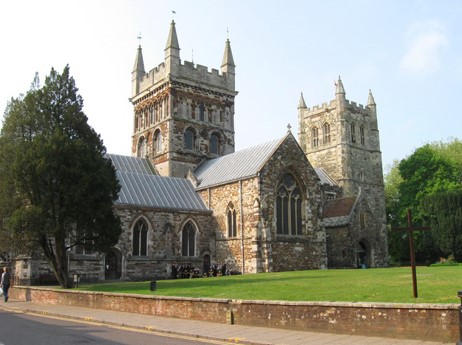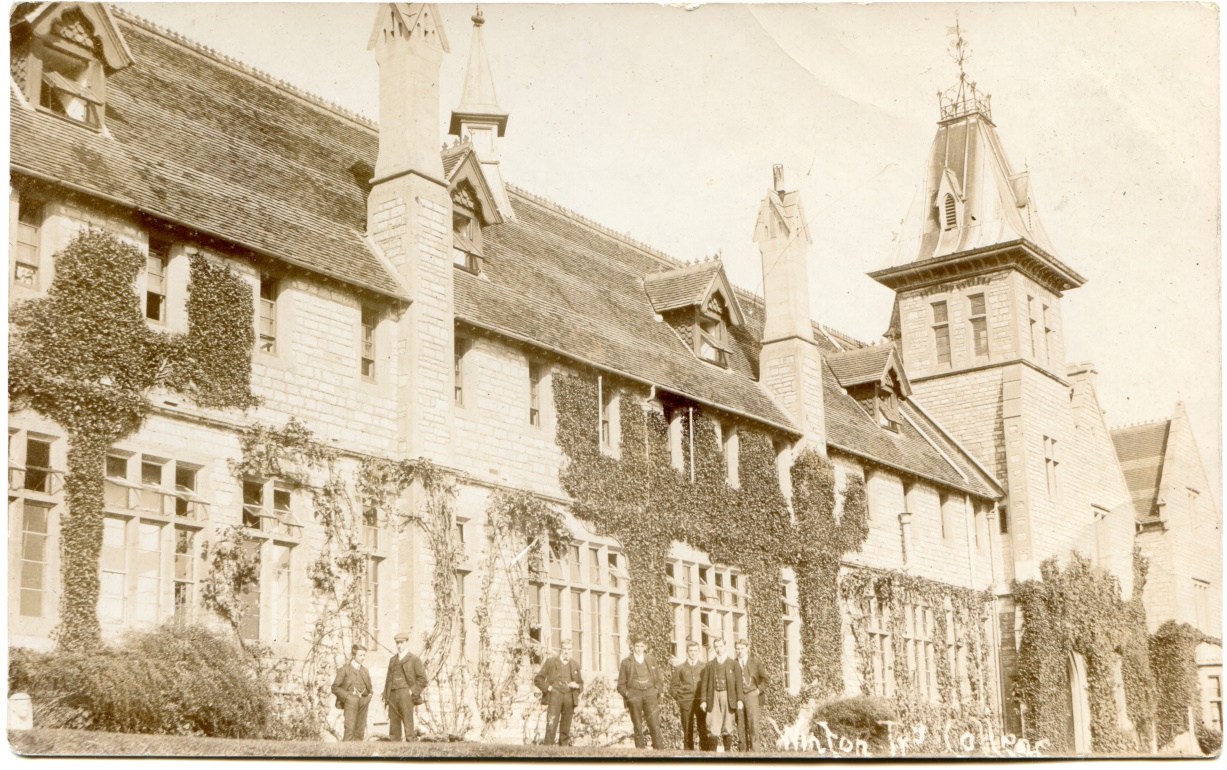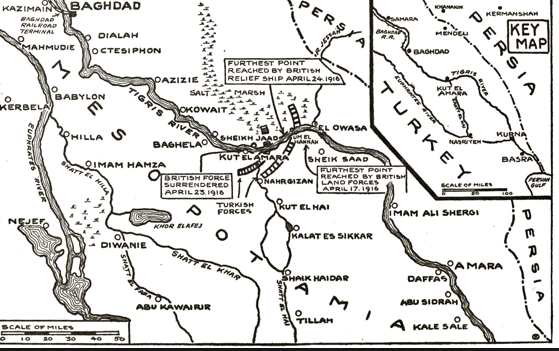Melville Golding Woodrow
Lance Corporal Melville Golding Woodrow, of 1/4th (attached to the 2/4th) Hampshire (TF) Regiment, Regimental Number 2201, died of illness, aged 28, on 27th July 1916, and is buried at Basra ,Iraq.
Early Life
Melville was born on 21st May 1888, to Robert and Mary (née Adams) Woodrow, in Wimborne, Dorset.
Wimborne Minster, Dorset
Melville was the youngest of six children. He was baptised on 11th June 1888. He had two sisters, Lillian (1878) and Ella (1880), and three brothers, Horace (1883), Raymond (1885) and Leslie (1887). Robert had been born in Marnhull, Dorset in 1846 and Mary in Westminster in 1852. The four eldest children were born in Mottisfont, Hampshire, where Robert was described as an estate carpenter. The estate in Mottisfont that seems most likely would have been Mottisfont Abbey. During the last decades of the nineteenth century Mottisfont was let to a wealthy banker, Daniel Meinertzhagen. The terms of the let were interesting in that they forbade the installation of electric lighting or central heating. The ten Meinertzhagen children built aviaries for their large collection of eagles, hawks, owls and ravens. As estate carpenter perhaps Robert was involved in the construction. Leslie and Melville were born in Gaunts, Wimborne Minster, Dorset. There was a large mansion at Gaunts which suggests that Robert was again working as an estate carpenter 1, when the 1891 census was recorded. Gaunts House was originally left to John of Gaunt by his wife Blanche around 1355. It became the family house of the Glyn family, owned at the time of 1891 census by Sir Richard George Glyn. The Glyn family held the baronetcies of Gaunts and Ewell. 2
Melville began his schooling at Milton Boys’ School, Hampshire and from there to Poole Secondary School in Dorset. By this time Melville’s family had moved to Suffolk. It is possible that Melville was living with another family member or boarding at the school.
By 1901 most of the family had moved to Dalham, Suffolk, where Robert was estate carpenter at Dalham Hall. The estate of Dalham Hall, near Newmarket, was bought in 1901 by Cecil Rhodes. 3 The estate was never lived in by Cecil Rhodes who died before he could move there. Instead it was passed to his brother Francis William Rhodes. 4 The three youngest Woodrow children were the only ones still living with their parents. Raymond, now 17, was following in his father’s footsteps and employed as a carpenter. No census record for the eldest child, Lillian has yet been found but in the first quarter of 1902 her death, aged 24, was registered in Milton, Kent. Ella was boarding with the delightfully named Salome Haggis, a widow, in Edwardstone, Suffolk, where she was working as an assistant schoolmistress. Tragically in the third quarter of 1902, her death was also recorded. Teaching was the profession chosen by Horace too and in 1901 he was boarding with Martha Caucutt, a widow, in Buckden, Huntingdon.
After leaving his secondary school, Melville was a pupil teacher at St. Peter’s Boys’ School in Parkstone, Dorset. By the 1911 census he was employed as an assistant teacher, at Stalbridge Boys’ School, where he worked for 3 ½ years, boarding with Henry Habershon in Stalbridge, Dorset. The 1912 and 1913 Electoral Roll describes his accommodation as one furnished room on the first floor. Stalbridge is situated in the Blackmore Vale area of North Dorset near the border with Somerset. There was a charity school established in Stalbridge in 1708. By the late nineteenth century the school was situated on Duck Lane.
Prior to college entry Melville took courses in Practical Elementary Science, Rural Science and the Science of Common Life, as well as drawing courses in model, freehand and geometrical drawing. There are two dates recorded in the College records for when he took the Preliminary Examination for the Certificate in 1909 and then in 1912 he was awarded the certificate. He gained a Class 2 pass on the Archbishops’ Exam for admission.
There were different routes into the teaching profession. The records seem to show that Melville was a provisionally certificated teacher on the grounds that his practical skill as a teacher was formally recognised by an Inspector. Melville would have been required to complete at least two years in a school as an assistant teacher before this could happen. His experience and skill was rewarded by the requirement to complete only one year at a training college rather than the usual two.
Winchester Training College
Melville arrived at Winchester Training College in 1913 at the age of 25. This was older than most of the students were when they began studying for their professional qualification but certainly not unique. There were several reasons why Melville may have delayed his admission to Winchester. The entry requirements to Training Colleges were stringent. Examinations needed to be studied for and passed before an application could be made. Some students who were working as uncertificated assistant teachers simply could not afford to support themselves for the two years it took to gain their qualification, even though the financial reward at the end would be significant. In Melville’s case, although we may never know for sure, it could have been that he was advised to stay as an assistant teacher. He must have been showing promise as a teacher and perhaps this was seen as a more satisfactory route into teaching for him.
Winchester Training College photograph courtesy of Alwyn Ladell
No individual information about Melville’s time at College has been found, but he was a classmate of Francis Chalmers who described his initial impressions of College.
We entered College on September 16th with much fear and trepidation, a select band of threewe had heard vague rumours of the peculiar climate of Winchester and the ordeals which newcomers had to undergo, and at first viewed everything and everyone with suspicionWe are now fairly launched on our College career, and so far our stay has been serene and fair. Everyone has done his utmost to make us welcome, and we are looking forward to a year beneficial to mind and body. 5
In 1914 when Melville was a student, the Training College was inspected. The Report on the work of the College and the standards that the students met was very favourable.
The Committee are able once more to state that the work of the Training College is being carried on with gratifying success and the work has proceeded in the same happy spirit as has characterised it for so many years pastThe Committee again have pleasure in expressing their cordial appreciation of the zealous and successful work carried out by the Principal and all the members of the College Staff, and of the results achieved, and their thankfulness that the same excellent tone continues to pervade this important institution.
In the summer of 1914, war was declared. The College premises were requisitioned for the duration of the war so students who had completed their Junior Year were given the option of completing their qualification at Bede College, Durham. Melville, being a one year certificated student, had completed his training and was mobilised on 5th August 1914.
From Hampshire to Mesopotamia
At the end of Melville’s first year at Winchester war was declared. It is likely that Melville was with the College Company, who had arrived at camp on Salisbury Plain from July 1914. Once war was declared on 4th August they were immediately mobilised, and after a period of training the 1/4th Hants left for Poona, India on the 9th October and the 2/4th Hants left for Quetta, also in India although now part of modern-day Pakistan, on 12th December 1914.
We know from his medal card that Melville entered the Mesopotamian theatre of war on 18th March 1915. He would have been sent along with others as reinforcements for the Expeditionary Force. At this point in the campaign Basra and Qurna had been occupied and an advance further inland was then started in April. Melville may have been involved in the advance, we have no documentary evidence to tell us of his particular part in this campaign. We do know however, that he was not part of the Expeditionary Force when the advance halted and Townshend’s force retreated to Kut“al-Amara. As the siege of Kut began, Melville would have become part of the Relief Force gathered to mount a rescue operation for the besieged troops. The Siege of Kut began on 7th December 1915, and the first attempt to reach them started at the beginning of January 1916.
Map of the area round Kut and the attempts of the Relief Force to reach them
This first attempt failed to progress beyond Hanna. Melville lost several of his friends as four alumni of the training college died that day, 21st January 1916, and one other was taken prisoner. The second attempt began in March and was halted at Dujailah Redoubt and Es Sinn. A third relief force push was blocked at Sannaiyat on 22nd April, failing to make it through to Kut. The garrison at Kut surrendered to the Turkish Commander Halil Bey on the 29th April 1916.
As the prisoners were marched into captivity and forced to endure horrific conditions, General Maude took over command of the Tigris Corps on 11th July 1916. The data published in 1920, gathered by Statistics of the Military Effort of the British Empire’ (London: HMSO, 1920), records that 12,678 men died of illness during the campaign in Mesopotamia. On the 27th July 1916 Melville, like so many other young men in Mesopotamia, died of cholera.
A study of soldiers of the Turkish army identifies infectious diseases such as typhoid, recurrent fever, dysentery and malaria as being responsible for more deaths in the army than bullets and bombs. Typhus, malaria and relapsing fever were transmitted via disease-infected lice, mosquitoes and ticks respectively. These were the most common killers, followed by bacterial diseases like dysentery and typhoid. Cholera was caused by infected water and food supplies, and was capable of killing large numbers of people. Cholera however was rare in comparison to typhus, which was so common that it was called military fever’ by Ottoman soldiers. The Allied Forces and the Prisoners of War held by the Turks after the capitulation at Kut would all have been living under similar conditions to the Turkish troops in Mesopotamia, and exposed to the same disease ridden insects and unsanitary conditions. Medical provision was not sufficient to cope with the large numbers of men who became ill from these diseases, as well as dealing with those who had been wounded in battle. Of the fourteen men from Winchester Training College who died during the campaign in Mesopotamia, nine died from illness, four were killed in action and one died of wounds.
Melville Woodrow is buried at Basra, Plot III Row S Grave 17. His parents Robert and Mary Woodrow were named as his next of kin and were by that time living at St Nicholas House, Ombersley Road, Droitwich.
Researcher and Author: Dee Sayers
Basra War Memorial photograph courtesy of cwgc
Signature from Students’ Register photograph by Dee Sayers
Footnotes
- The 1891 census gives Robert’s occupation simply as carpenter but the previous and later census record him as estate carpenter.
- Ewell in Surrey.
- Cecil Rhodes 1853-1902 was a British businessman, mining magnate and politician in southern Africa. He was Prime Minister of the Cape Colony from 1890-1896 and a staunch believer in British imperialism. Rhodes, with his British South Africa Company founded the territory of Rhodesia, now modern-day Zimbabwe and Zambia.
- In 1928 Dalham Hall became a stud and is now owned by Sheikh Mohammed bin Rashid al Maktoum.
- Francis Chalmers (13-14) The Wintonian Magazine 1910-1914
Sources
Alwyn Ladell photography. (2018). Home page. [online] Available at: https://www.flickr.com/photos/alwyn_ladell/sets/72157665876163520/ [Accessed 2018].
Ancestry (2018). Home page. [online] Available at: www.ancestry.co.uk [Accessed 2018].
Commonwealth War Graves Commission, (2018). Home page. [online] Available at www.cwgc.org/ [Accessed 2018].
Epsom and Ewell History Explorer (2011). The Glyns. [online] Available at: http://epsomandewellhistoryexplorer.org.uk/Glyns0.html [Accessed 2018].
Gaunts House (2018). About. [online] Available at: https://www.gauntshouse.com/home [Accessed 2018].
International Encyclopedia of the First World War (2018). Home page. [onl;ine] Available at: https://encyclopedia.1914-1918-online.net/home.html [Accessed 2018]
The Long Long Trail, (2018). Welcome to the long long trail. [online] Available at: http://www.longlongtrail.co.uk/ [Accessed 2018].
Vickers, J. University of Winchester Chapel Memorial Rail image.
Wikimedia (2018). File:Kut-el-Amara-map.jpg [online] Available at: https://commons.wikimedia.org/wiki/File:Kut-el-Amara-map.jpg [Accessed 2018].
Wikipedia (2018). Cecil Rhodes. [online] Available at: https://en.wikipedia.org/wiki/Cecil_Rhodes [Accessed 2018].
Wikipedia (2018). Dalham Hall. [online] Available at: https://en.wikipedia.org/wiki/Dalham_Hall [Accessed 2018].
Wikipedia (2018). Mottisfont. [online] Available at: https://en.wikipedia.org/wiki/Mottisfont [Accessed 2018].
| University of Winchester Archive “ Hampshire Record Office | ||
| Reference code | Record | |
| 47M91W/ | P2/4 | The Wintonian 1899-1900 |
| 47M91W/ | P2/5 | The Wintonian 1901-1902 |
| 47M91W/ | P2/6 | The Wintonian 1903-1904 |
| 47M91W/ | P2/7 | The Wintonian 1904-1906 |
| 47M91W/ | P2/8 | The Wintonian 1905-1907 |
| 47M91W/ | P2/10 | The Wintonian 1908-1910 |
| 47M91W/ | P2/11 | The Wintonian 1910-1914 |
| 47M91W/ | P2/12 | The Wintonian 1920-1925 |
| 47M91W/ | D1/2 | The Student Register |
| 47M91W/ | S5//5/10 | Photograph of 5 alumni in Mesopotamia |
| 47M91W/ | Q3/6 | A Khaki Diary |
| 47M91W/ | B1/2 | Reports of Training College 1913-1914 |
| 47M91W/ | Q1/5 | Report and Balance Sheets 1904- 1949 |
| 47M91W/ | R2/5 | History of the Volunteers Company 1910 |
| 47M91W/ | L1/2 | College Rules 1920 |
| Hampshire Record Office archive | ||
| 71M88W/6 | List of Prisoners at Kut | |
| 55M81W/PJ1 | Managers’ Minute Book 1876-1903 | |
| All material referenced as 47M91W/ is the copyright of The University of Winchester. Permission to reproduce photographs and other material for this narrative has been agreed by the University and Hampshire Record Office. | ||






